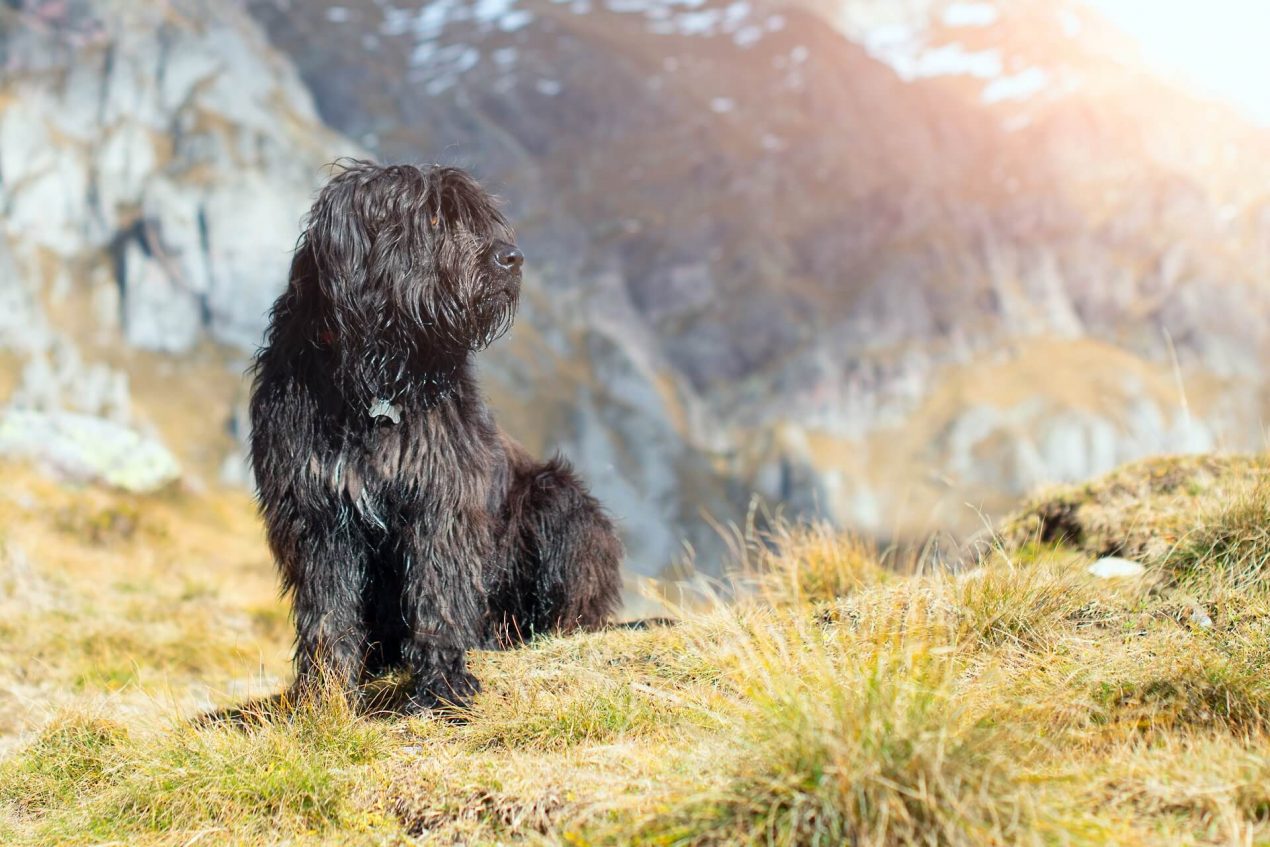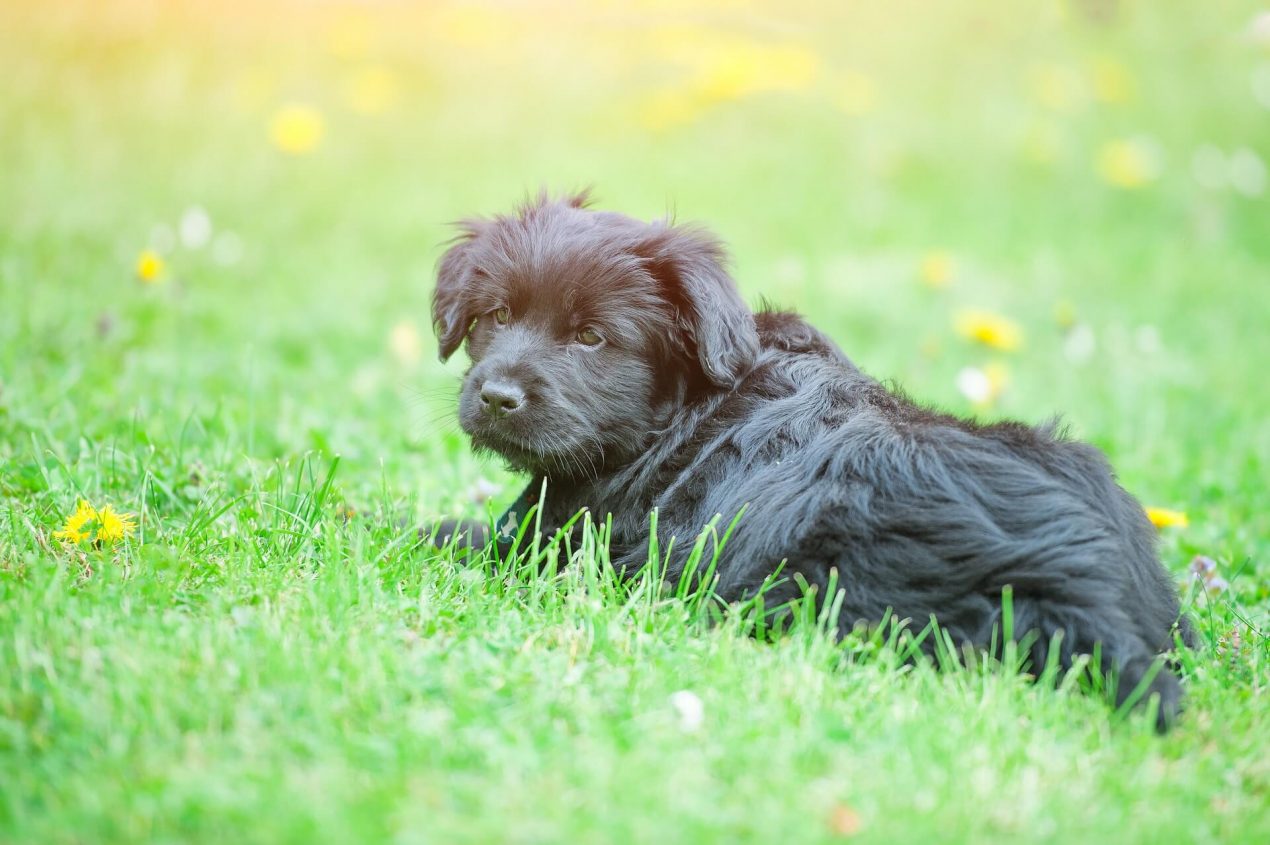Few are familiar with the shaggy Bergamasco Shepherd, as it is not widely spread. Yet, with its patient, affectionate character, it is quite suitable as a family dog. You’ll learn about the origins of this four-legged companion and all there is to know about the shepherd dog below.
History of the Bergamasco Shepherd
The Bergamasco Shepherd breed is very, very old, having served shepherds as loyal and reliable working and herding dogs for thousands of years. The exact origins of the Bergamasco Shepherd are not definitively documented. Some speculate that the shepherd dog, while tending to the herd with nomads, made its way from Eastern Europe to Europe in the Italian Alps. Even today, among nomadic peoples in the Hungarian Puszta, the French or Italian Alps, you can find shepherd dogs similar to the Bergamasco, such as the Komondor, Puli, or Briard.
It may be related to the Chien de Brie, also adorned with “goat hair.” Others claim that the Bergamasco Shepherd descended from Persian shepherd dogs, and its ancestors arrived in Italy with Roman and Phoenician soldiers from Asia about 2000 years ago. The Bergamasco Shepherd is mentioned in old writings by wandering shepherds of the Italian Alps from the 16th century. Its Italian name “Cane da Pastore Bergamasco” or “Cane delle Alpi” means “dog of the shepherds of Bergamo” or “dog of the Alps,” respectively. This indicates that it was kept and bred as a working dog in this area around Bergamo in the Italian Alps by shepherds.
Even today, it is primarily bred for the needs of shepherds, which is why its distribution is relatively low. There are only about 2000 specimens of the Bergamasco Shepherd worldwide.
In 1891, the shepherd dog was registered as “Cane da Pastore Bergamasco” in the Italian studbook with the first breed standard. In the early 1950s, the Bergamasco Shepherd was registered in the Swiss studbook, and in 1959, it was recognized as an Italian herding and working dog by the International Dog Federation FCI. The Bergamasco Shepherd is listed under FCI standard number 194, belongs to FCI Group 1 “Herding dogs and driving dogs (without Swiss mountain dogs),” Section 1 “Shepherd dogs.”
Breed Overview
GROUP: Herding
HEIGHT: 22 inches (female), 23.5 inches (male)
WEIGHT: 57 to 71 pounds (female), 70 to 84 pounds (male)
COAT: Long, corded
COAT COLOR: Black or gray, can have black patches
LIFE SPAN: 13 to 15 years
TEMPERAMENT: Intelligent, protective, companionable
HYPOALLERGENIC: Yes
ORIGIN: Italy
Appearance of the Bergamasco Shepherd
The Cane da Pastore Bergamasco stands out with its robust, shaggy appearance like no other dog. Except for its head, ears, and shoulder area, it bears long, floor-length felt locks, known as dreadlocks. Like a coat, the felt hair mats lie over the sturdy, muscular body of the medium-sized quadruped. Its thick, tapered tail, reaching to the ankle, is covered with slightly wavy “goat hair” and hanging dreads.
In a resting position, the Bergamasco Shepherd carries its tail curved like a saber and swings it back and forth like a flag while walking. Its eyes, dark or light chestnut brown depending on the coat color, are hardly visible due to the falling forehead hair. The Bergamasco Shepherd has a black sniffing nose and high-set, triangular, semi-drooping ears.
Character and Temperament
The Bergamasco’s character is characterized by independent thinking, willingness to work, good-naturedness, and affection for humans. These qualities have been and still are essential for a good shepherd dog. As an extremely industrious shepherd dog, it still herds and drives sheep together in Italy today. If not kept as a working dog, it absolutely needs meaningful alternative activities.
The intelligent shepherd dog is used to making decisions independently during his work. Therefore, he can question the commands of his “master” if they do not seem sensible to him. However, he is extremely teachable, attentive, and quick to react. Rain or shine, he is absolutely reliable in his duties. The faithful shaggy bear is very vigilant and fearless, guarding the herd entrusted to him or his home extremely conscientiously.
Since he is very balanced, affectionate, and devoted, he also makes a good family dog, provided he is mentally and physically challenged. Being alone is very difficult for the Bergamasco. He needs unconditional closeness to his human pack to be happy. If allowed, he accompanies his “replacement herd” everywhere and reliably herds them. He seems to be always vigilant even in his sleep. The Bergamasco behaves good-naturedly and patiently towards children. He also encounters strangers in a good-natured and calm manner.
| Affection Level | Medium |
| Friendliness | Medium |
| Kid-Friendly | Medium |
| Pet-Friendly | Medium |
| Exercise Needs | Medium |
| Playfulness | Medium |
| Energy Level | Medium |
| Trainability | Medium |
| Intelligence | High |
| Tendency to Bark | Low |
| Amount of Shedding | Low |

How to Care for a Bergamasco?
The working animal should not be housed in a small apartment in the city. As a shepherd dog, he is used to having plenty of space and being outdoors in nature frequently. However, the affectionate herding dog should never have to live alone outside in the yard or kennel. Because there he would wither away. A house with a large garden provides the Bergamasco with an adequate home where he feels comfortable.
Activities with the Bergamasco
The Italian shepherd dog needs a task that challenges him mentally and physically to be happy and relaxed at home. He is suitable for almost any sport in any weather, such as jogging, cycling, or horse riding. He loves extensive, varied hikes, intelligence games, learning tricks, and dog sports. The Bergamasco is extremely teachable and versatile, so many dog sports are suitable for him. For example, agility, dog dancing, mantrailing, treibball, or training as a rescue, tracking, or therapy dog.
Health and Care
Since the Bergamasco is bred very little, it is a very primitive and robust breed that enjoys excellent health. Therefore, no health examinations are required for breeding, except for hip x-rays. Well-groomed and fed, the shaggy-haired Italian lives to be between 12 and 15 years old.
The shepherd dog is not very picky about his food. But you should definitely feed him a balanced diet to keep him fit and healthy for a long time. In addition to a sufficiently high meat content, his food should also contain enough minerals and vitamins. However, flavor enhancers, sugar, and chemical additives should not be included. Dry food is suitable for the long-haired Bergamasco because it keeps him clean around the muzzle area. In addition to the quality and type of food, you should also dose the amount of food correctly, depending on how active, old, or healthy the dog is.
Coat Care
Taking care of the shepherd dog’s coat is quite simple. If you leave the Bergamasco’s coat in its primitive state, you generally never need to brush it. Only the rougher topcoat, also called goat hair, in the head, tail, and shoulder area should be brushed once a week. The Bergamasco does not shed any undercoat and therefore does not shed at all. Over time, its undercoat intertwines with the woolly topcoat, causing it to felt like sheep. Felt plates form, which can be divided into tassels. Occasionally, you can trim the tassels to prevent them from hindering the herding dog’s movement.
If you do not intend to breed the Bergamasco or show him in typical breed dog shows, you can turn the small shaggy bear into a charming and well-groomed shepherd dog in an afro style. To do this, you must regularly comb him from an early age. Then you’ll think you have a completely different dog in front of you. It is best to use a brush and a trimming comb to remove his undercoat. If you prefer a tidy Bergamasco with short hair, you will need to groom him regularly or take him to a dog groomer. The advantage of a combed or shaved Bergamasco is that it does not harbor dirt and debris in its matted dreads. And after a rainy walk, it smells much less like a dog than the shepherd dog with its poorly drying, dog-scented tassels.
Like any dog, the rustic furry nose should receive regular dental care with a dog toothbrush, toothpaste, and chew bones. This minimizes the risk of the four-legged friend being plagued by tartar or cavities.
Puppy Development and Training
Bergamasco puppies are very teachable and can be trained well with love, consistency, and praise. Sometimes the Bergamasco shepherd dog can seem quite stubborn, but this merely means that he questions a command. Because the four-legged friend is used to working and thinking independently as a herding dog. Like all puppies, the little shaggy bear should be well socialized from an early age. Therefore, you should attend puppy school with the bundle of energy. There, he comes into contact with other four-legged friends and learns to behave playfully. Otherwise, the little Bergamasco must be gently accustomed to all unfamiliar things. These include, for example, other pets, visits to the vet, car rides, coat and dental care, or off-leash activities.

Acquiring a Bergamasco
You should only acquire a Bergamasco shepherd dog if you are active enough and willing to properly stimulate the four-legged friend. The energy package is less suitable for seniors. If you have fallen in love with the four-legged Italian with dreadlocks as a novice dog owner, you should have read sufficient dog literature beforehand. Furthermore, you should be willing to lovingly and consistently train the sometimes headstrong shepherd dog.
If you want to buy a purebred Bergamasco, this can be very difficult, as they are extremely rare worldwide. The Bergamasco shepherd dog is only bred very rarely with about 200 breeding animals worldwide. You will certainly have to travel long distances and endure long waiting times. In Switzerland, you will find a few Bergamasco breeders, and in Italy, about 100 Bergamasco puppies are registered in the studbook annually. On average, only 20 puppies are recorded annually in the United States.
What should I consider when buying?
Only purchase Bergamasco puppies from reputable breeders registered with a breeding association. Registered breeders must adhere to the applicable breeding regulations and only use healthy animals for breeding. They are also subject to constant inspections. The puppies should be vaccinated, microchipped, and dewormed multiple times, and have spent their first weeks of life in a clean environment. You will pay approximately $800 for a Bergamasco puppy with registration papers. Conscientious breeders only release their one to three puppies per litter from the age of 8 weeks.
Do you also have a Bergamasco or are you planning to get one soon? Tell me more in the comments!


